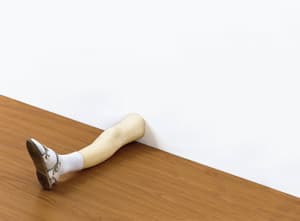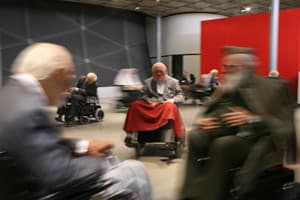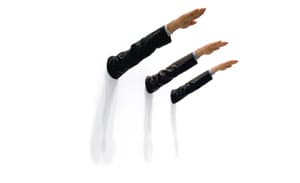
Body and satire
Sun Yuan and Peng Yu’s practice provides a means to challenge systems of social and political authority. Their mechanical theatre presents as a strange, dreamlike retirement home for world leaders, where the sculptures move as though controlled by outside forces. Old people’s home simultaneously critiques and pokes fun at stereotypical male figures occupying powerful positions on the world stage.
In the space nearby, the defectiveness and fragility of the human body are the focus of Robert Gober’s Untitled. Made from wax, which produces the effect of vulnerable-looking skin, the artist has also spoken of the erotic appeal of a man’s leg. While making his first leg-effigy, he realised it was ‘the sight you see if you glance under a stall in a men’s room’. In this way, his cast legs refer to an unsettling form of realism, one closely and simultaneously associated with trauma, phantasy and pleasure.
Elsewhere, Maurizio Cattelan’s three wax-figure arms adopt a particularly loaded gesture. The ‘Roman salute’, commonly (although probably mistakenly) associated with classical Roman soldiers, was infamously adopted by Italian Fascists during the 1920s and by the Nazi Party in Germany. At the same time the title of the work, Ave Maria, invokes that most familiar of Catholic prayers, playfully flipping the experience of the work between an expectation of piety and reverence and the realisation of violence and evil.





